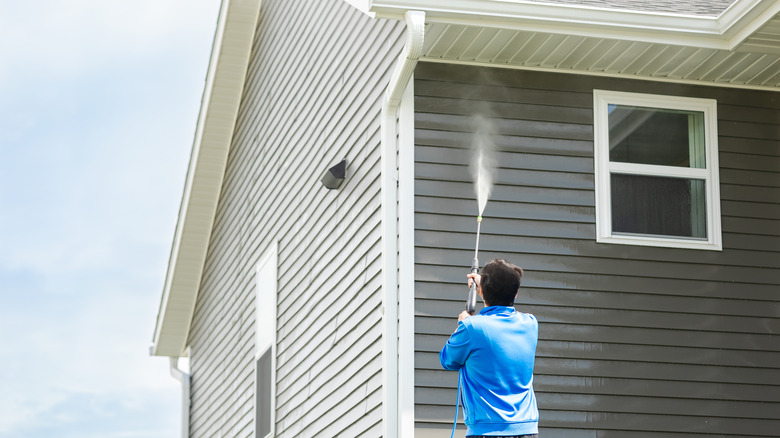3 Areas In Your Home You Should Avoid Pressure Washing
Using a pressure washer in hard-to-clean areas of your home can make a difficult task simple, but this method isn't always ideal for certain spots. Some portions of your foundation or house can take the intensity, while others may suffer from the high pressure of the water. Removing tough stains, dirt, or other refuse is essential to keeping an appealing exterior, but if done incorrectly, it could end up costing you in damages. Knowing which areas of your home benefit from this kind of cleaning and which don't can help you make the most of the tool and protect your home. According to First Coast Home Pros, it is important not to underestimate how intense a pressure washer's stream is.
When it comes to using this method, you should avoid using the instrument on shingles, gutters, and windows. These portions of your home can withstand intense weather and other elements, but they are still fragile in some ways. Turning a high-pressure jet of water on these areas could result in breakages, breakdowns, and unnecessary repairs that could've otherwise been avoided. The following details can help explain why to keep your pressure washer away from these spots and how to clean them instead.
Shingles
Your asphalt shingles are vital in protecting your roof and home from water damage. But while they are ideal for keeping rain and other weather elements out, they shouldn't be subjected to high-pressure water jets. According to Peter's Pressure Washing, using a pressure washer on asphalt shingles will strip the protective coating off, leaving them exposed to the elements rather than safe from them. When this happens, leaks can make their way into your roof, and the shingles will start to deteriorate more rapidly.
Replacing your roof's shingles can get expensive, especially if they become damaged before their time. They should last anywhere from 15 to 20 years, but pressure washing can shorten their lifespan. Instead of using an intense stream of water to remove dirt, grime, mold, moss, and other residues, GJ Keller recommends placing a spray attachment to your garden hose and rinsing shingles with a water and chlorine bleach mixture.
Windows
Your window panes help to keep everything from wind and rain to bugs and refuse out of your home, but they are only made to withstand raindrops or possibly hail. They don't have the proper strength to withstand high-pressure water streams and could crack or break if these are applied. Not only could the jet shatter the window, but it could also knock it out completely. Not only would you have to replace the missing pane, but the water from the pressure washer would be all over your floors, furniture, and anything else that stood behind the window.
According to All Clean Services, pressure washers can also harm the sealant used in double-paned windows. When this is damaged or broken, moisture builds up between the panes. You will start to notice a foggy sheen in your windows from the moisture, and mold can start to grow over time. To properly clean glass without harming it, use a sponge or microfiber cloth and a solution of white vinegar and warm water, which Ideal Home says you can make yourself. Use a broom handle or the brush portion to get rid of cobwebs and hard-to-reach dust.
Gutters
Gutters are crucial to keeping your home's foundation, interior, and exterior safe from water damage. These units act as shoots that redirect rain, snow, and other moisture away from a structure, which protects paint, materials, and the surrounding ground. Keeping these clean is important because it helps clear a path for any water that runs through them, and you might be tempted to use a pressured stream to tidy up. While gutters are resilient to weather and day-to-day elements, pressure washers can damage them, causing problems for your home. Because of how intense the jet is when it comes out of the tool, there is the possibility the gutter will be torn off of the house completely.
To clean out these integral units without damaging them or your home, you can use a standard garden hose or a bucket filled with water. Carefully use a ladder to reach your gutters, then run the hose inside of them to wash away dirt. You can also remove debris like leaves and twigs by hand, placing all detritus into a plastic bag to safely bring down when you're done. If you prefer to use a bucket, DIY Doctor suggests filling it up on the ground and then carrying it up the ladder before pouring it along the gutter track in the direction of the downpipe.



